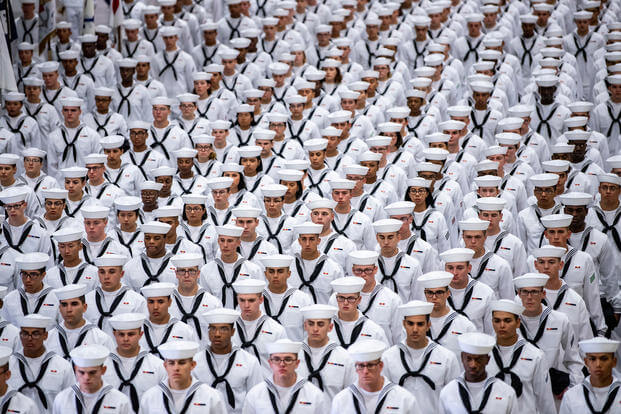The Navy's top officer has received dozens of recommendations to improve inclusion and diversity in the ranks that could change everything from who appears in recruitment ads, to how promotion selection boards are assembled, and how new ships are named.
Task Force One Navy presented 56 recommendations to Chief of Naval Operations Adm. Mike Gilday last month. Gilday created the task force last summer to examine Navy policies at every stage of a sailor's career to stop any unfair practices that might be putting people at a disadvantage due to their race, gender, sexual orientation, age or other factors.
He did so after the death of George Floyd, a Black man who died in police custody, prompted a national reckoning over race relations in the country.
Read Next: Commissioning of Navy LCS Minneapolis-St. Paul on Hold After Design Defect Discovered
For too long, the Navy has fallen short by excluding or limiting opportunities for some in the ranks, Gilday said this week when the task force released its 141-page report.
"As a Navy -- uniform and civilian, active and reserve -- we cannot tolerate discrimination of any kind, and must engage in open and honest conversations with each other and take action," he said. "... Simply put, all Sailors -- uniformed and civilian -- and applicants for accession to the Navy must be treated with dignity and respect above all else."
Task Force One Navy held hundreds of listening sessions and focus groups and collected nearly 1,000 completed online surveys that influenced its recommendations. Rear Adm. Alvin Holsey, who led the task force and recently commanded Carrier Strike Group 1, said the Navy is focused on carrying out the recommendations in the report.
From boot camp to the highest levels in the Navy, Holsey said, leaders will continue to reinforce the importance of inclusion and diversity.
Gilday agreed, saying that, while there's work to be done, the task force's recommendations will help make the Navy better long-term.
"Make no mistake, I am personally committed to this effort," he said.
The task force covered five "lines of effort," focusing on potential fixes for recruiting; talent management and retention; professional development; innovation; and other miscellaneous recommendations.
The recommendations start with who appears in recruiting materials and how the Navy can better appeal to minorities. The task force also recommends getting rid of aptitude rating test requirements for new officers to remove any barriers from standardized testing.
The Marine Corps last year swapped a World War II-era exam it was giving new officers for a modern aptitude test after white and male officers were found to be performing better than women and minorities, raising questions about possible biases.
Once sailors and officers are in, Chief of Naval Personnel Vice Adm. John Nowell said the Navy wants to be sure everyone's getting a fair shot at advancement and professional development.
Twice a year, Nowell said, top leaders across the Navy's 17 communities will meet and have to show what their inclusion and diversity efforts look like across different pay grades.
"This is not about quotas," he stressed. "This is about, 'How do we make sure that as we look at things like mentoring, at advocacy, that we're paying attention?'"
The report also suggests ways to diversify the officer ranks through college scholarship programs that target underrepresented communities. The officer corps has historically been less diverse than the enlisted side.
The task force also recommends creating a STEM -- or science, technology, engineering and mathematics -- program for elementary, middle and high schools. That effort could raise awareness about opportunities to serve in the Navy, the report states, potentially increasing the number of minorities with STEM backgrounds in the military.
Other recommendations include creating a high-level women's policy adviser in the Navy and reviewing how the service names ships and other assets to ensure they represent naval core values.
The listening sessions that brought about some of the recommendations were raw conversations about discrimination Navy personnel have faced in their careers. Military.com observed one of the sessions last summer. Sailors described hearing the the N-word on duty, being told to stop speaking Spanish on a ship, and facing snide comments about their hairstyles.
Leaders need to continue having those conversations with their sailors, even when they're uncomfortable, Nowell said.
Holsey and other members of the task force acknowledge that there's skepticism from those in uniform that the task force's efforts will lead to real change. At nearly every listening session the task force held, he said participants expressed that they didn't expect any change to come out of Task Force One Navy.
Jane Roberts, the task force's senior civilian adviser, said women and minorities often feel like it's their burden to teach everyone else about diversity and inclusion.
But this effort has support at the most senior levels, Holsey said, adding that it's not going to be any one individual's burden to keep the conversation and effort going.
"I think there's a concerted effort to make it right," he said. "... It's not a 'one and done.' This issue is not going to go away. It's going to be embedded in our training throughout the life of the sailor.
"We're all in on this, and that's why it will make a difference."
Editor's note: This story was updated to reflect the total number of recommendations from the task force.
-- Gina Harkins can be reached at gina.harkins@military.com. Follow her on Twitter @ginaaharkins.
Related: 'Sailors Using the N-Word': Navy Leaders Hear Painful Cases of Racism













